laws
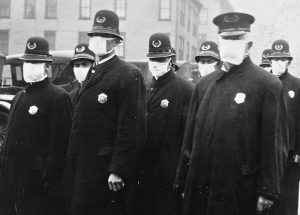 As the Covid-19 Pandemic has spread across our nation, so has the battle for or against the wearing of face masks. Part of the problem has been the conflicting analysis as to the value of the masks between one doctor and another, one politician and another, or even the same doctor at different times during the crisis. Many states, cities, and even establishments have rules about wearing a mask, with varied levels of enforcement. Of course, we were told to “shelter in place” and close any “non-essential” businesses, a catastrophic event for the economy. Everything from schools to bars, and theaters to salons was closed. Cities became virtual ghost towns, and things like Facebook and Twitter, Zoom and Google Classroom, texting and phone calls became vital. People’s sanity began to take a hit, and loneliness became the norm…especially for anyone who lived alone.
As the Covid-19 Pandemic has spread across our nation, so has the battle for or against the wearing of face masks. Part of the problem has been the conflicting analysis as to the value of the masks between one doctor and another, one politician and another, or even the same doctor at different times during the crisis. Many states, cities, and even establishments have rules about wearing a mask, with varied levels of enforcement. Of course, we were told to “shelter in place” and close any “non-essential” businesses, a catastrophic event for the economy. Everything from schools to bars, and theaters to salons was closed. Cities became virtual ghost towns, and things like Facebook and Twitter, Zoom and Google Classroom, texting and phone calls became vital. People’s sanity began to take a hit, and loneliness became the norm…especially for anyone who lived alone.
It’s been a grim time, but it isn’t the first time. During the 1918 Spanish Flu Pandemic, mask wearing started with the first masks being made out of gauze, which was quite porous. Still, in an effort to stop the spread, or as we would say these days, flatten the curve, all the people were now asked to wear masks. In fact, in the Fall of 1918, it became mandatory. With the second surge in December 1918, new restrictions went into place. The January 1919 ordinance had a much larger impact in creating resistance to wearing a mask in public by American citizens. However, it too was short lived, and on February 1, 1919 the city ordinance requiring every citizen of San Francisco going out in public to wear masks was voted down. The mandatory mask laws for COVID-19 are not new. This has already happened twice in American history and if you do feel strongly about not wearing one, it has been protested successfully before in a pandemic caused by a much deadlier virus.
I don’t believe the resistance, with was called the Anti-Mask League of San Francisco fell along party lines, like 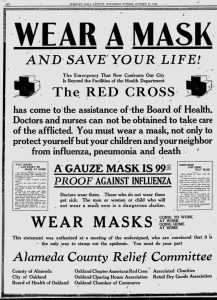 much of today’s resistance seems to be, but were rather a diverse bunch of individuals with varying professional backgrounds. Its members included physicians, libertarians, and many others. Many of the same arguments we have today, were in place then, and it is debatable as to whether or not the masks of today are any better than the ones back then…with the possible exception of the medical grad hazard wear, the N-95 mask, and the Head gear. Pretty much everything we’ve tried with Covic-19 was also used in 1918 to try to prevent the spread of the flu…close schools, wear masks, don’t cough or sneeze in someone’s face, avoid large events and hold them outside when possible, and of course, no spitting. There were many ways to get the word out, like in Philadelphia, where streetcar signs warned “Spit Spreads Death.” In New York City, officials enforced no-spitting ordinances and encouraged residents to cough or sneeze into handkerchiefs (a practice that caught on after the pandemic). The city’s health department even advised people not to kiss “except through a handkerchief,” and wire reports spread the message around the country. I don’t know…does any of this sound familiar to you, because it sure does to me. I guess there really is nothing new under the sun. In western states, some cities even called mask ordinances a patriotic duty. In October 1918, the San Francisco Chronicle ran a public service announcement telling readers that “The man or woman or child who will not wear a mask now is a dangerous slacker.” This was in reference to the type of World War I “slacker” who didn’t help the war effort. One sign in California threatened, “Wear a Mask or Go to Jail.” The PSA in the Chronicle appeared on October 22, just over a week before San Francisco had scheduled its mask ordinance to begin on November 1. It was signed by the mayor, the city’s board of health, the American Red Cross and several other departments and organizations, and it was very clear about its message: “Wear a Mask and Save Your Life!”
much of today’s resistance seems to be, but were rather a diverse bunch of individuals with varying professional backgrounds. Its members included physicians, libertarians, and many others. Many of the same arguments we have today, were in place then, and it is debatable as to whether or not the masks of today are any better than the ones back then…with the possible exception of the medical grad hazard wear, the N-95 mask, and the Head gear. Pretty much everything we’ve tried with Covic-19 was also used in 1918 to try to prevent the spread of the flu…close schools, wear masks, don’t cough or sneeze in someone’s face, avoid large events and hold them outside when possible, and of course, no spitting. There were many ways to get the word out, like in Philadelphia, where streetcar signs warned “Spit Spreads Death.” In New York City, officials enforced no-spitting ordinances and encouraged residents to cough or sneeze into handkerchiefs (a practice that caught on after the pandemic). The city’s health department even advised people not to kiss “except through a handkerchief,” and wire reports spread the message around the country. I don’t know…does any of this sound familiar to you, because it sure does to me. I guess there really is nothing new under the sun. In western states, some cities even called mask ordinances a patriotic duty. In October 1918, the San Francisco Chronicle ran a public service announcement telling readers that “The man or woman or child who will not wear a mask now is a dangerous slacker.” This was in reference to the type of World War I “slacker” who didn’t help the war effort. One sign in California threatened, “Wear a Mask or Go to Jail.” The PSA in the Chronicle appeared on October 22, just over a week before San Francisco had scheduled its mask ordinance to begin on November 1. It was signed by the mayor, the city’s board of health, the American Red Cross and several other departments and organizations, and it was very clear about its message: “Wear a Mask and Save Your Life!”
“Red Cross headquarters in San Francisco made 5,000 masks available to the public at 11:00am, October 22. By noon it had none,” wrote the late historian Alfred W Crosby in America’s Forgotten Pandemic: The Influenza of 1918. “By noon the next day Red Cross headquarters had dispensed 40,000 masks. By the twenty-sixth 100,000 had been distributed in the city… In addition, San Franciscans were making thousands for themselves.” Lasting from February 1918 to April 1920, the Spanish Flu Pandemic infected 500 million people…about a third 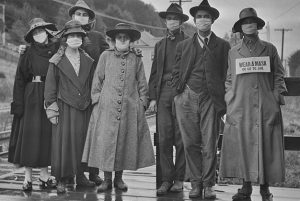 of the world’s population at the time, in four successive waves. The death toll is typically estimated to have been somewhere between 17 million and 50 million, and possibly as high as 100 million, making it one of the deadliest pandemics in human history. With all the safeguards, and the lack of success in “stopping the spread,” I guess it is up to each individual to decide on the effectiveness, or the lack thereof, concerning the safeguards that were put in place. To me, it seems that we have done pretty much the same things today as they did in 1918, so only time will tell us if they were successful, or a waste of time and money. Still, since the Spanish Flue had 4 waves, it doesn’t seem like we successfully stopped anything.
of the world’s population at the time, in four successive waves. The death toll is typically estimated to have been somewhere between 17 million and 50 million, and possibly as high as 100 million, making it one of the deadliest pandemics in human history. With all the safeguards, and the lack of success in “stopping the spread,” I guess it is up to each individual to decide on the effectiveness, or the lack thereof, concerning the safeguards that were put in place. To me, it seems that we have done pretty much the same things today as they did in 1918, so only time will tell us if they were successful, or a waste of time and money. Still, since the Spanish Flue had 4 waves, it doesn’t seem like we successfully stopped anything.
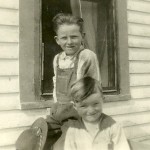 Opinions vary on the matter of child labor, and who can legally have their child work and at what kind of job. Some people take it to the point of saying that children shouldn’t even do chores around the home, which is, in my opinion, silly. It is my thought that children need to be helping out around the house, but beyond that I suppose the water gets a little bit murky. In the distant past, children were farmed out to spend their days working at a job that should have been done by an adult, and the kids really had no childhood to speak of. That is cruel treatment, and the current child labor laws prevent that from happening…unless people are so illegal that they do it without the knowledge of the government.
Opinions vary on the matter of child labor, and who can legally have their child work and at what kind of job. Some people take it to the point of saying that children shouldn’t even do chores around the home, which is, in my opinion, silly. It is my thought that children need to be helping out around the house, but beyond that I suppose the water gets a little bit murky. In the distant past, children were farmed out to spend their days working at a job that should have been done by an adult, and the kids really had no childhood to speak of. That is cruel treatment, and the current child labor laws prevent that from happening…unless people are so illegal that they do it without the knowledge of the government.
That said, there is a group of kids…even today that do work every day, and it is not illegal at all. These are the children of farmers and ranchers. I don’t know of any of those kids who don’t help out around the farm or ranch. There are stables to be cleaned, and cows to be milked, and animals to feed. There are also crops to be cared for and planted. These kids work and there is nothing illegal about it. Of course, their parents do have to 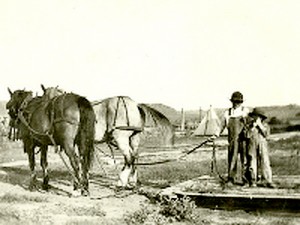 be careful on a few matters. The children must get their schooling, and they have to be working on the parents farm or ranch.
be careful on a few matters. The children must get their schooling, and they have to be working on the parents farm or ranch.
Such was the case for my husband’s great uncles and his grandfather. Many people owned farms when those boys were young, and the kids helped out with just about everything. Most families back then really couldn’t afford to hire the amount of workers that it would take to run the place, so they hired what they had to, and the kids learned to work. I really can’t say that I think this is a bad thing. The kids often like the work…especially taking care of horses…since they often get to ride them too.
If you look back on the lives of our parents and grandparents, you will find that many of them grew up on a farm or ranch, and most of them were working to help out on the place at a very young age. Really, what a wonderful way to bond with the parents. Running a ranch or farm is a big job, and most kids like to do the things their parents are doing, because they want to be just like their parents. If a child is interested in doing the same kind of work their parents do, or take over the family farm, they need to know how to do this from the bottom up. What better way could there be, than to help out as a child.

Of course, not every family owns a farm or ranch, and while they may live in the country, they don’t have that kind of work to do. Still, the kids can and should help out with things. My nephew, Barry Schulenberg, loved helping his grandpa split firewood. He ran the splitter while his grandpa loaded the wood into it. Barry was about 4 years old, but you couldn’t have pulled him away from that job for anything. He was the one who did that, and that was all there was to it. Maybe some people would think he was a bit young, but there was never a single accident when he worked the splitter. I think sometimes we don’t give these kids enough credt. They can often do more than we think they can. They just need to be given a chance.

